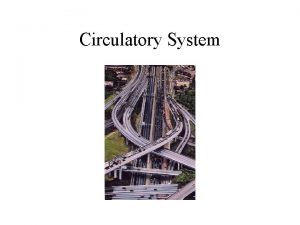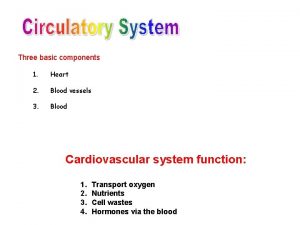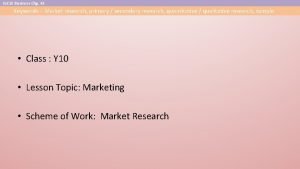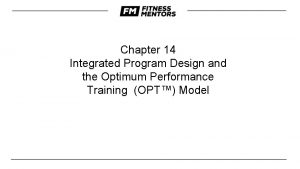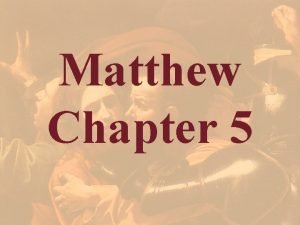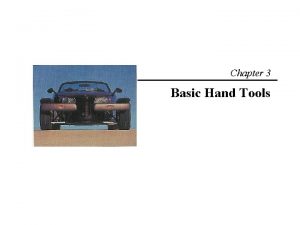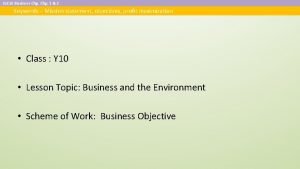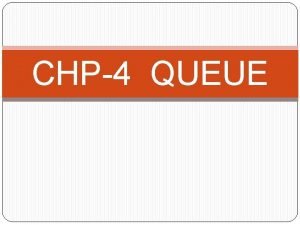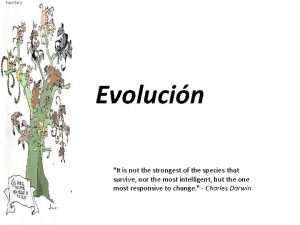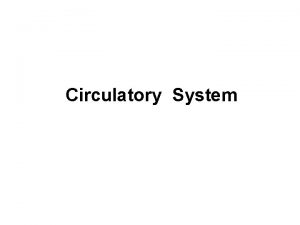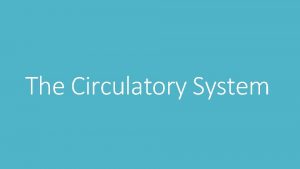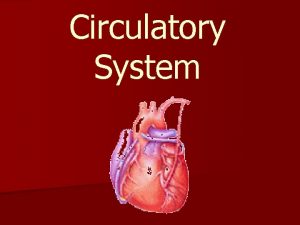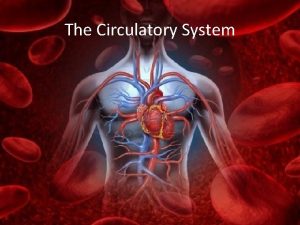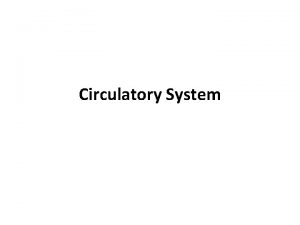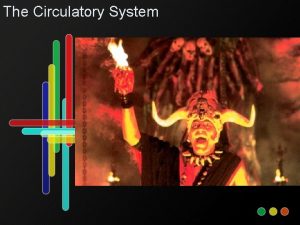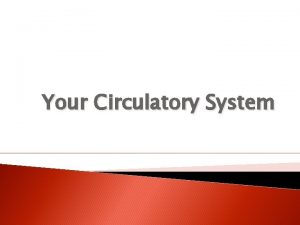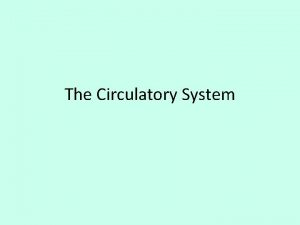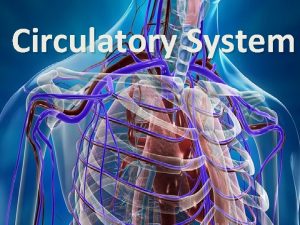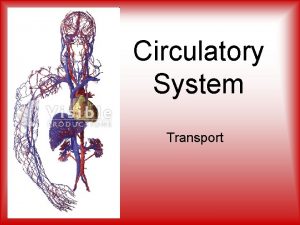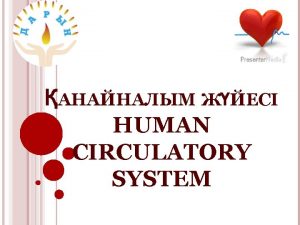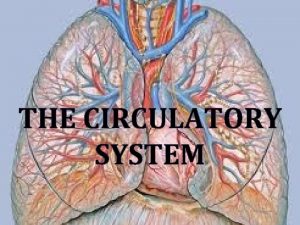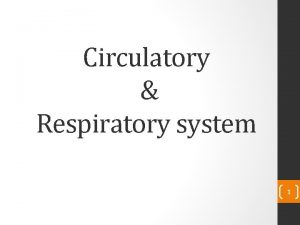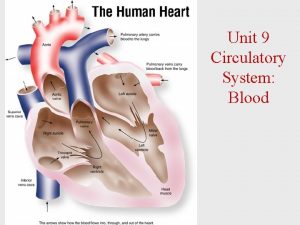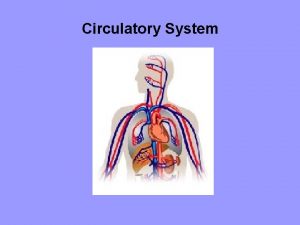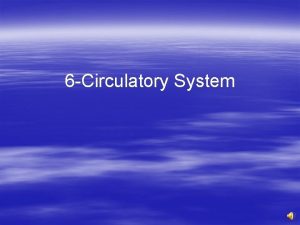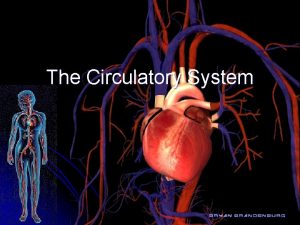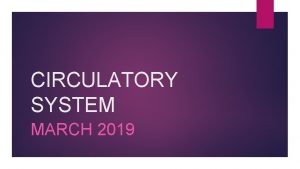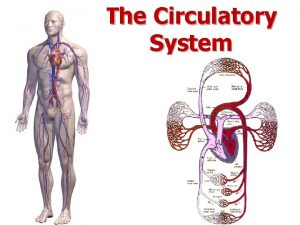Transport System chp 30 Functions of the Circulatory

























- Slides: 25

Transport System (chp. 30)

Functions of the Circulatory System • Delivers nutrients and oxygen to cells • Transports hormones throughout the body • Carries away cellular waste • Helps repair tissue • Protects the body from infection What are the 3 primary components of this system? Intro Video

Blood • A type of connective tissue made up of cells and liquid • What kinds of cells? • 55% = Plasma: 90% H 2 O, 10% salts, other • 45% = red blood cells, some wbc and platelets Blood video

Blood – each drop contains • About 5 million rbc, each of which has • About 250 million molecules of hemoglobin • Hemoglobin: contains iron, which attracts oxygen and temporarily binds to. O 2 so that it can be carried to cells • Produced in the red bone marrow • No nucleus in a mature rbc

Blood – each drop contains • 4, 000 -11, 000 White blood cells, each of which has • A nucleus and mitochondria and are responsible for fighting infection • 250, 000 – 500, 000 platelets responsible for clotting • Release clotting factor which initiates a chain of reactions which results in protein threads called fibrin

HEART: Vertebrates have closed systems but vary in the heart chambers Fish: 2 Amphibian: 3 Mammal and Bird: 4 The four chamber heart separates oxygen rich from oxygen poor blood

Label the diagram of the heart. Oxygen rich/ oxygen poor? Heart video

Control of the Heart Cycle Nerves send impulses to the “pacemaker” on the right atrium of the heart. Accelerator increases rate Vagus decreases rate Hormone adrenaline increases rate during the “fight / flight mechanism”

Human Circulation Blood Vessels: Trace the path of blood in the human system. Arteries: Arterioles: Capillaries: Veinioles: Veins: Blood vessels

Blood flow in the veins is aided by the surrounding muscles and valves that prevent back flow.

Blood in the arteries is under pressure from the heart. Look at what happens to the blood flow as it passes through the vessels. Blood Pressure video

How is blood pressure measured? Systolic is the pressure of the ventricles contracting Diastolic is the pressure during the relaxation or ventricles refilling. Pressure cuff is called a sphygmomanometer.

How do nutrients and oxygen get to cells? ? ? • Interstitial space • Blood pressure • diffusion

Role of the Lymphatic System • Returns 4 liters of blood, in the form of lymph, back to circulatory system via a network of capillaries and lymph vessels

Leading Causes of Death (All figures are for U. S. ) Final 2000 data Ten Leading Causes of Death in the U. S. : Heart Disease: 710, 760 Cancer: 553, 091 Stroke: 167, 661 Chronic Lower Respiratory Disease: 122, 009 Accidents: 97, 900 Diabetes: 69, 301 Pneumonia/Influenza: 65, 313 Alzheimer's Disease: 49, 558 Nephritis, nephrotic syndrome, and nephrosis: 37, 251 Septicemia: 31, 224 http: //www. cdc. gov/nchs/fastats/lcod. htm

Malfunctions of circulatory system: Heart attack: coronary arteries blocked Stroke: aneurism or clot in brain Hypertension: high blood pressure Antheroschlerosis: narrowing of arteries due to plague buildup Arterioschlerosis: hardening of this plague Normal Artery Atherosclerosis

Stroke Fact Sheet

Respiratory System • The flow of Air: Mouth/nose (inhale)→ pharynx [air passes through the voice box or the _______, which contain the (2) vocal cords] Q: How do you make sounds/talk? Pharynx → windpipe [also known as the ______]. This tube maintains its shape by c-shaped rings of cartilage. Trachea → 2 bronchi [air tubes that connect the trachea to the lungs] → (2) lungs [sponge-like tissue, each about the size of a football, that function in the exchange of oxygen and carbon dioxide with the blood. ] Function of Larynx Each Bronchus → branches repeatedly into finer and finer tubes called bronchioles. Each bronchiole ends in millions of grapelike clusters of tiny air sacs called alveoli (singular, alveolus). The Human Respiratory System

Respiratory System The inner surface of each alveolus, as well as the entire respiratory system, is lined with a layer of moist epithelial cells. Using “diffusion” , “hemoglobin” and “capillaries”, describe to me how oxygen from the air reaches your cells and how carbon dioxide is expelled. In the trachea, bronchi, and the epithelial cells are covered with cilia and a fine layer of mucus, which act like cleaning elements. The mucus traps foreign particles. The cilia then sweep the mucus -trapped particles up toward the pharynx where they can be swallowed.

Respiratory System Breathing - the process of moving air into and out of your lungs; usually involuntary. On average, you breathe about 15 times per minute (~ 21, 000 breaths each day). A sheet of muscle called the diaphragm, which forms the bottom wall of the chest cavity, plays a key role in breathing. Inhale: diaphragm and rib muscles contract, which expands your chest cavity, increasing the volume in the lungs (volume ↑ then air pressure ↓). Q: What does this mean to air flow? Exhale: when your diaphragm and rib muscles relax. (volume ↓ air pressure ↑). Breathing

The rate of breathing is controlled, not by the oxygen level in the blood but by the carbon dioxide level. The increased carbon dioxide dissolved in the blood slightly lowers its p. H. A drop in p. H level causes the brain to send nerve impulses that increase breathing rate. As a result, more carbon dioxide is exhaled, and the p. H returns to normal.

Smoking Related Diseases • Smoking a cigarette exposes the smoker to more than 4, 000 different chemicals, including carbon monoxide, ammonia, and hydrogen cyanide. The toxic substances in tobacco smoke irritate the cells lining the bronchi and destroy the cilia. • What happens if no cilia? • No cilia = greater risk for diseases caused by foreign particles (toxins from the cigarette and air pollution, dust, and airborne bacteria). • Increased risk for developing cancers of the lung, bladder, pancreas, mouth, throat, and several other organs. (smokers account for 90% all lung cancer cases).

Smoking Related Diseases • Emphysema – the walls of the alveoli to lose their elasticity, resulting in air being trapped inside the alveoli during exhalation. • Smoking also increases the risk for some of the cardiovascular diseases partly because smoking can increase harmful cholesterol levels. Also, the damage of smoking to the respiratory system requires the heart to work harder to deliver enough oxygen to the cells. • Trivia: smokers (≥ 1 pack/day) lives an average of seven years less than someone who has never smoked. [ Good News ! After 10 years of not smoking, the chances of getting lung cancer and heart disease return to normal levels]. • Why do so many people smoke when they know it’s not good for you?

Tobacco is addictive Painting by Vinnie van Gogh • Nicotine: makes ALL tobacco products addictive; is easily absorbed through the skin and mucous membranes. • Nicotine reaches the brain within 10 seconds of inhaling and sends signal to increase the level of dopamine [neurotransmitter in the brain- controls pleasurable feelings]. Short-lived feeling. • To maintain the high dopamine levels, the body craves more nicotine. If smoker takes 10 puffs on one cig. and smokes 30 cigs. /day = 300 doses of nicotine. • Nearly 35 million people try to stop smoking every year and less than 7 % are successful (quitting for more than one year). People who start do not realize how hard it is to quit. The majority of adult smokers say they wish they had never started smoking.

END
 Circularory system
Circularory system Function of the circulatory system
Function of the circulatory system Pericardiu
Pericardiu How respiratory system work with circulatory system
How respiratory system work with circulatory system Circulatory system and respiratory system work together
Circulatory system and respiratory system work together Bit program california
Bit program california Yenifer chp vr
Yenifer chp vr Market research igcse
Market research igcse Opt.model
Opt.model Mathew 5
Mathew 5 Struck or hammered tools
Struck or hammered tools Mission statement keywords
Mission statement keywords Double ended queue
Double ended queue Chp 14
Chp 14 Decp
Decp Seleccion natural direccional
Seleccion natural direccional Community housing partners christiansburg va
Community housing partners christiansburg va Antiporter
Antiporter Primary vs secondary active transport
Primary vs secondary active transport Now answer the questions
Now answer the questions Active vs passive transport venn diagram
Active vs passive transport venn diagram Unlike passive transport, active transport requires
Unlike passive transport, active transport requires Primary active transport vs secondary active transport
Primary active transport vs secondary active transport Bioflix activity membrane transport active transport
Bioflix activity membrane transport active transport What is passive transport
What is passive transport Bioflix activity membrane transport diffusion
Bioflix activity membrane transport diffusion

